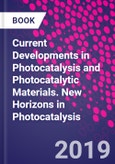Photocatalytic materials can improve the efficiency and sustainability of processes and offer novel ways to address issues across a wide range of fields-from sustainable chemistry and energy production to environmental remediation. Current Developments in Photocatalysis and Photocatalytic Materials provides an overview of the latest advances in this field, offering insight into the chemistry and activity of the latest generation of photocatalytic materials.After an introduction to photocatalysis and photocatalytic materials, this book goes on to outline a wide selection of photocatalytic materials, not only covering typical metal oxide photocatalysts such as TiO2 but also exploring newly developed organic semiconducting photocatalysts, such as g-C3N4.Drawing on the experience of an expert team of contributors, Current Developments in Photocatalysis and Photocatalytic Materials highlights the new horizons of photocatalysis, in which photocatalytic materials will come to play an important role in our day-to-day lives.
Please Note: This is an On Demand product, delivery may take up to 11 working days after payment has been received.
Table of Contents
1. Introduction2. Rutile TiO2-based New Photocatalysts for Visible-light Water Oxidation
3. Factors Affecting Photocatalytic Activity of TiO2
4. Controllable Synthesis of TiO2: Toward an Efficient Photocatalyst
5. TiO2-based Photocatalytic Conversion Processes: Insights from In Situ Infrared Spectroscopy
6. Photoreduction of CO2 on non-TiO2 Based Metal Oxides
7. Titania Based Photocatalyst for Dynamic Degradation of VOCs
8. Solvothermal Alcoholysis Preparation of TiO2 with Tailored Structures and Enhanced Activity in Environmental and Energy Photocatalysis
9. TiO2 Polymorphs for Hydrogen Photoproduction
10. Progress in Fundamental Studies and Practical Applications of SrTiO3 Photocatalysts to Overall Water Splitting
11. Environmental Friendly Synthesis of High Efficient Composite Type Photocatalysts
12. Photocatalytic Conversion of CO2 by H2O over Heterogeneous Photocatalysts
13. Seizing Solar Hydrogen from Water Promoted by Magic Spin Transporting, Chiral-induced Spin State-selective Filtering, and Upconversion
14. Recent Advances in the Development of Photocatalytic NOx Abatement
15. ZnO Nanomaterials: Strategies for Improvement of Photocatalytic and Photoelectrochemical Activities
16. BiVO4, a Ternary Metal Oxide as an Efficient Photocatalytic Material
17. Photocatalytic and Photo-Fenton-catalytic Degradation of Organic Pollutants by BiFO3 (BFO) and BiVO4 (BVO) Photocatalysts under Visible-light Irradiation
18. Preparation and Photocatalytic Performance of Monolayer Inorganic Oxide Nanosheets
19. TiO2/carbon Composite Nanomaterials for Photocatalysis
20. The Design and Development of MOF Photocatalysts and Their Applications for Water Splitting Reaction
21. Light-induced Organic Transformations over some MOF Materials
22. Mesoporous Silica supported Ag based-Plasmonic Photocatalysts
23. Development of Metal Sulfide-based Photocatalysts for Hydrogen Evolution Under Visible Light
24. Photocatalysis with Octahedral Sulphides
25. Reduced Graphene Oxide (rGO) Supported on Metal Oxides Catalysts for Photocatalytic Reactions
26. Current Development of Graphitic Carbon Nitride Photocatalysts as One of Organic Semiconducting Photocatalytic Materials
27. Carbon Nitride as Photocatalyst in Organic Selective Transformations
28. Heterogeneous Photocatalysis by Organic Materials: From Fundamental to Applications
29. Photocatalytic Performance of Hexagonal Boron Carbon Nitride Nanomaterials
30. Theoretical Studies of Two-dimensional Photocatalyst Materials
31. Atomically Scale Design of Van der Waals Heterostructures as Photocatalysts
Authors
Xinchen Wang Dean of the College of Chemistry, State Key Laboratory of Photocatalysis on Energy and Environment, Fuzhou University - Fuzhou, China. Prof. Xinchen Wang is currently the director of the State Key Laboratory of Photocatalysis on Energy and Environment, and the dean of college of chemistry in Fuzhou University. He obtained his BSc and MSc in Fuzhou University, and went to The Chinese University of Hong Kong to pursue his PhD. In 2006, he moved to Tokyo University as a JSPS post-doctor, then he went to Max Planck Institute of Colloide and Interfaces, Germany, as Alexander von Humboldt fellow, and was promoted as a Group Leader during 2008-2012. He started his professorship in Fuzhou University at 2005. His research interests cover catalysis and photocatalysis, and in this research field he published more than 200 peer-reviewed papers with H-index of 96. Masakazu Anpo Special Honor Professor and International Advisor, Fuzhou University, Fuzhou, ChinaEmeritus Professor, Osaka Prefecture University, Osaka, Japan. Prof. Masakazu Anpo is presently a Special Honor Professor & International Advisor of the State Key Laboratory of Photocatalysis on Energy and Environment, Fuzhou University. He worked for 40 years at Osaka Prefecture University and served as Dean, Vice President & Executive Director for last 10 years and is now a Professor Emeritus. He is a pioneer in the research of photochemical reactions on solid surfaces, design of visible-light-responsive TiO2 photocatalysts, and single-site heterogeneous photocatalysts constructed within zeolites. He is the editor-in-chief of Res. Chem. Intermed. (Springer). He has published more than 100 books and 500 original peer-reviewed papers. He is a member of Academia Europaea and Science Council of Japan. Xianzhi Fu President, Fuzhou University - Fuzhou, China. Prof. Xianzhi Fu received his Ph.D. degree in Physical Chemistry from Peking University, China, in 1991. He did postdoctoral research on catalysis and photocatalysis at Peking University and University of Wisconsin-Madison, respectively. He joined Fuzhou University in 1997 where he was promoted to a full professor in 1998. Currently, he is the President of Fuzhou University. His research interests are mainly focused on Photocatalysis. He is the author or co-author of more than 300 peer-reviewed scientific publications and 40 patents. Professor Fu has won many important awards including the National Science and Technology Progress Award. He was elected as a member of the Chinese Academy of Engineering in 2009.








